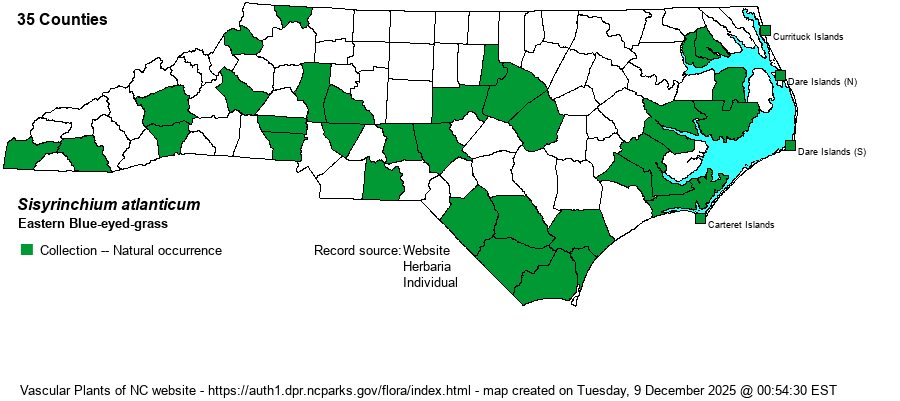| Author | Bicknell | |
| Distribution | Found across the state, but mostly coastally and in the southern half, and of sparse distribution in the northern Mountains and nearly all of the northernmost Piedmont. It potentially could occur in many more counties if specimens in other herbaria were annotated. Our map reflects specimens recently annotated at NCU; other herbaria's specimens are often confused with S. angustifolium and have generally not been mapped. Specimens from UNCC have also been included, as the range of its counties seems to roughly match that as seen on the BONAP map. Details of the range in the state are thus not completely clear -- though it does range essentially statewide though might be legitimately absent in the northern Piedmont, as it seems to be in Virginia's Piedmont as well.
This species has a wide range in the Eastern states, but it is mostly found from NC and MO southward to northern FL and eastern TX. North of NC, it is quite scattered and a bit disjunct, with main occurrences in New England south to NJ and eastern VA. Thus, the overall range does imply that the absence of records for a large number of northern counties in NC is real and not an artifact of collecting. | |
| Abundance | Fairly common, at least locally, near the coast and in the Tidewater zone. Farther inland, infrequent in the southern and central portions of all three provinces. However, rare and not well known in the northern Mountains and most of the northern Piedmont and adjacent northwestern Coastal Plain. | |
| Habitat | This species favors dry to damp sunny ground (vs. moist or even wet in S. angustifolium). Habitats in NC are mostly dry to damp ground in the Coastal Plain, which can include savannas, interdune swales, marsh edges (including salt marshes). However, over much of the state it occurs in sunny uplands, such as in grasslands, woodland openings, and roadsides. | |
| Phenology | Blooms from March into June, and fruits from June to August. | |
| Identification | Treatments in RAB (1968) and many other works are not at all satisfactory, due to confusion with other species; FNA and Weakley (2018) treatments are OK. This species has notably glaucescent (pale) green leaves and stems, versus plain green in S. angustifolium. In addition, it often grows in extensive grass-like clumps, but so do other species. The flowering stalk is very slender, barely 1/10-inch wide (even though it is slightly winged); it ranges up to 1 foot high. The leaves are also narrow and flattened, and grow to only about half the height of the flowering stalk. The plant usually has several branched stems in the inflorescence, each with one or two bright blue to lighter blue flowers at the tip. The flowers average a bit more than 1/2-inch across. Most importantly, the fruits when mature are black or blackish, not brown or brownish as in S. angustifolium. In general, you will identify this species more by its slender, pale green stem and leaves, and black fruits (turning blackish even when immature). It is not at all related to S. mucronatum, which has red to maroon coloring to the spathe (vs. pale green). | |
| Taxonomic Comments | Some older references, such as RAB (1968), considered this as just a variety of S. mucronatum -- S. mucronatum var. atlanticum. However, all recent references do consider S. atlanticum as a valid species.
| |
| Other Common Name(s) | Atlantic Blue-eyed-grass, Bicknell's Blue-eyed-grass | |
| State Rank | S3S4 [S4] | |
| Global Rank | G5 | |
| State Status | | |
| US Status | | |
| USACE-agcp | FACW link |
| USACE-emp | FACW link |

